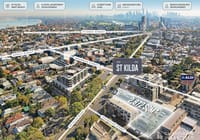
Construction pins its turnaround hopes on defence spending boost
Contractors and consultants are counting on a pick-up in defence spending to boost demand for buildings and infrastructure as new figures show total project value of the country’s largest builders dropped 8 per cent last year.
Increasing demands for more Australian defence facilities in a world where the US-dominated post-WWII geopolitical order was changing and pledges by local politicians to boost defence spending made the sector “a sleeper” that could wake up soon, BESIX Watpac chief executive Mark Baker said.

“We’re living in circumstances where there’s a heightened threat of security,” Baker told The Australian Financial Review. “Defence is looking to spend a significant amount of money in the future.”
The figures from data provider BCI Central show the value of new projects started by the largest 50 builders fell last calendar year to $33.17 billion from $36.11 billion a year earlier, and the industry hopes an increase in defence spending will help offset the slowdown in sectors such as office, retail and civic infrastructure work, which includes libraries and public buildings.
The campaign leading up to Saturday’s federal election has increased the focus on defence expenditure. The Labor government, which after its Defence Strategic Review in 2023 said it would increase defence spending by $19 billion over four years, plans to lift spending from 2.05 per cent of GDP to 2.4 per cent by 2034.
The Coalition, meanwhile, plans to lift it to 2.5 per cent by 2030 and has flagged an aspiration to raise it to 3 per cent.
Military spending requires sheds and spaces to support it.
“As a rough rule of thumb, every dollar spent on additional defence capability means approximately 10¢ being spent on supporting infrastructure,” said Damian Drain, the defence sector lead at design firm GHD.
“Increased spending as a percentage of GDP will mean more opportunities for designers and contractors, especially in AUKUS-related works and Northern Base infrastructure.”
The opportunities for builders are already clear. Brisbane-based BESIX Watpac, which has done defence-related work for 30 years, is bidding or planning to bid for Australian Naval Infrastructure projects including tripling the submarine construction yard of Osborne Naval Shipyard in South Australia to about 65 hectares.
It is also bidding for work upgrading facilities in Puckapunyal and Edinburgh military precincts to support the army’s Long Range Fires program as well as the navy’s Littoral Manoeuvre Program to develop coastal and amphibious boats.
But while smaller states such as South Australia, Western Australia and Queensland were performing strongly, a wider pick-up in construction was unlikely until economies in the two largest states recovered, Baker said.

“We’re still going to be down overall on value for a period of time until the NSW and Victorian economies start to gather momentum and put more projects into the market.”
A slowdown in public spending and increases in the costs of finance, materials and labour have hit both commercial and residential construction and even with economists expecting further cuts in borrowing costs this year, a significant improvement in spending on new projects remains far off.
The slowdown also reflects the effect of a 17 per cent year-on-year surge in construction industry insolvencies that has cut capacity across the industry as a growing number of businesses go under.
Figures corporate regulator ASIC published this week put construction industry insolvency appointments for the financial year to April 13 at 2795, up from 2398 at the end of April last year.
The BCI Central ranking – which BESIX Watpac topped with a total project value of $3.45 billion – shows that among the 10 top-ranked builders the slowdown was sharpest in sectors such as civic/social infrastructure, where project value sank 41 per cent from $11 billion to $6.5 billion.
Starts of commercial construction – in hospitality, office and retail property – among the top 10 builders also hit the brakes, sinking from $5.94 billion to $3.80 billion, the BCI Central data shows.
Residential construction did pick up, however, with the value of housing work started by the 10 largest builders doubling to $4.52 billion from $2.17 billion.
“What we’re seeing is a structural shift in what Australia is building and why,” said Ashleigh Pattison, Asia-Pacific region project content head at BCI Central parent company Hubexo.
“Despite a cooling property market, underlying housing demand remains strong and is still commanding serious investment.”
The report also showed the value of industrial projects started by the 10 largest builders during 2024 jumped 29 per cent.
Baker said sectors such as data centre and health facility construction was strong and the growth in non-traditional centres reflected a maturing of development in this country.
“There’s a lot of opportunities of the traditional commercial building and residential,” he said.
“I see still a very strong surge in health spending across the board. Australia seems to be a save haven for data centres worldwide. Data centres are a big part of the market.”
A key example of health infrastructure spending is in Queensland, where Premier David Crisafulli last month said he would continue a project to expand 11 hospitals, build three new ones as well as a specialist cancer care facility. The projected cost of the project started by the former Labor government had blown out to $17 billion from a predicted $9.8 billion, but the new LNP premier said he would slow work down and spread out expected completion dates.
A weaker sector last year was infrastructure and contractor John Holland, which topped the 2023 ranking with $6.8 billion worth of project starts in the often-clunky sector, didn’t feature anywhere in the 2024 ranking because its project volumes weren’t high enough, a BCI Central spokesman said.
But as public infrastructure spending slowed, builders in the civil space were facing worse prospects than commercial contractors, Baker said.
“Their view of the world is where we were four years ago. It’s tough.”
The annual ranking, based on data from BCI Central’s lead manager platform, showed BESIX Watpac led the BCI Central ranking, followed by Built ($3 billion), Multiplex ($2.87 billion), Hutchinson Builders ($1.73 billion), Hickory ($1.62 billion), Kane Constructions ($1.28 billion), ADCO Constructions ($1.27 billion), FDC Construction & Fitout ($1.22 billion), Icon ($1.1 billion) and Richard Crookes Constructions ($1.03 billion).











